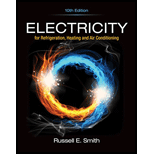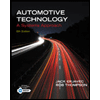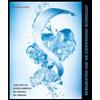
Electricity for Refrigeration, Heating, and Air Conditioning (MindTap Course List)
10th Edition
ISBN: 9781337399128
Author: Russell E. Smith
Publisher: Cengage Learning
expand_more
expand_more
format_list_bulleted
Concept explainers
Textbook Question
Chapter 4, Problem 1RQ
What are the three most common electric meters used in the industry?
Expert Solution & Answer
To determine
The type of three most commonly used electric meters in the industry.
Explanation of Solution
An electric meter is a device utilized to measure various electrical variables or characteristics of a circuit. The most commonly used electric meters are listed below:
- Ammeter –– Used to measure the current flowing in an electric circuit. There are two types of ammeters.
- Voltmeter –– Used to measure the potential difference between two specific points in a circuit.
- Ohmmeter –– Used to measure the resistance of the component associated in a circuit.
Want to see more full solutions like this?
Subscribe now to access step-by-step solutions to millions of textbook problems written by subject matter experts!
Students have asked these similar questions
Vertical configuration for hydraulic power units are usually used for applications which require smaller power
a. True
b. False
What happens to an electrical circuit when thereis unwanted resistance in it?
Metrology is the measurement of:
Mass
Length
Time
All the above
Chapter 4 Solutions
Electricity for Refrigeration, Heating, and Air Conditioning (MindTap Course List)
Ch. 4 - What are the three most common electric meters...Ch. 4 - Prob. 2RQCh. 4 - What do most analog meters use to facilitate the...Ch. 4 - How does an ammeter work?Ch. 4 - What are the two types of ammeters? Which type is...Ch. 4 - Prob. 6RQCh. 4 - How can a very small ampere draw be measured with...Ch. 4 - If a conductor was wrapped around the jaws of a...Ch. 4 - Explain the operation of an analog voltmeter.Ch. 4 - Air-conditioning or refrigeration equipment can...
Ch. 4 - Prob. 11RQCh. 4 - What precaution should be taken when using an...Ch. 4 - Prob. 13RQCh. 4 - What is a short circuit?Ch. 4 - Prob. 15RQCh. 4 - What factors should be considered when purchasing...Ch. 4 - Match the following terms.Ch. 4 - Prob. 18RQCh. 4 - Prob. 19RQCh. 4 - An in-line ammeter must be connected to a circuit...Ch. 4 - What is the difference between an analog meter...Ch. 4 - Give three advantages of a digital electric meter.Ch. 4 - What basic concept is used in a digital meter to...Ch. 4 - What is the basic accuracy of most analog and...Ch. 4 - How many digits will the 312- and 412-digit...Ch. 4 - Prob. 26RQCh. 4 - The ohmmeter differs from other types of meters in...Ch. 4 - Compare the digital and analog types of electric...
Knowledge Booster
Learn more about
Need a deep-dive on the concept behind this application? Look no further. Learn more about this topic, mechanical-engineering and related others by exploring similar questions and additional content below.Similar questions
arrow_back_ios
SEE MORE QUESTIONS
arrow_forward_ios
Recommended textbooks for you
 Automotive Technology: A Systems Approach (MindTa...Mechanical EngineeringISBN:9781133612315Author:Jack Erjavec, Rob ThompsonPublisher:Cengage Learning
Automotive Technology: A Systems Approach (MindTa...Mechanical EngineeringISBN:9781133612315Author:Jack Erjavec, Rob ThompsonPublisher:Cengage Learning Refrigeration and Air Conditioning Technology (Mi...Mechanical EngineeringISBN:9781305578296Author:John Tomczyk, Eugene Silberstein, Bill Whitman, Bill JohnsonPublisher:Cengage Learning
Refrigeration and Air Conditioning Technology (Mi...Mechanical EngineeringISBN:9781305578296Author:John Tomczyk, Eugene Silberstein, Bill Whitman, Bill JohnsonPublisher:Cengage Learning

Automotive Technology: A Systems Approach (MindTa...
Mechanical Engineering
ISBN:9781133612315
Author:Jack Erjavec, Rob Thompson
Publisher:Cengage Learning

Refrigeration and Air Conditioning Technology (Mi...
Mechanical Engineering
ISBN:9781305578296
Author:John Tomczyk, Eugene Silberstein, Bill Whitman, Bill Johnson
Publisher:Cengage Learning
Heat Transfer [Conduction, Convection, and Radiation]; Author: Mike Sammartano;https://www.youtube.com/watch?v=kNZi12OV9Xc;License: Standard youtube license